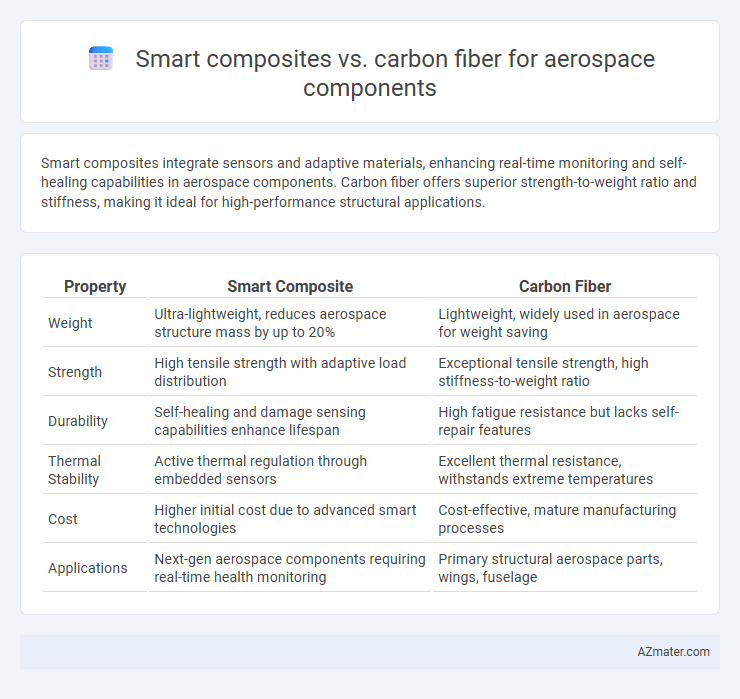Smart composites integrate sensors and adaptive materials, enhancing real-time monitoring and self-healing capabilities in aerospace components. Carbon fiber offers superior strength-to-weight ratio and stiffness, making it ideal for high-performance structural applications.
Table of Comparison
| Property | Smart Composite | Carbon Fiber |
|---|---|---|
| Weight | Ultra-lightweight, reduces aerospace structure mass by up to 20% | Lightweight, widely used in aerospace for weight saving |
| Strength | High tensile strength with adaptive load distribution | Exceptional tensile strength, high stiffness-to-weight ratio |
| Durability | Self-healing and damage sensing capabilities enhance lifespan | High fatigue resistance but lacks self-repair features |
| Thermal Stability | Active thermal regulation through embedded sensors | Excellent thermal resistance, withstands extreme temperatures |
| Cost | Higher initial cost due to advanced smart technologies | Cost-effective, mature manufacturing processes |
| Applications | Next-gen aerospace components requiring real-time health monitoring | Primary structural aerospace parts, wings, fuselage |
Introduction to Smart Composites and Carbon Fiber
Smart composites integrate advanced materials like piezoelectric fibers and sensors within traditional composite matrices to provide self-sensing, self-healing, and adaptive capabilities, enhancing aerospace component performance and durability. Carbon fiber composites, composed of high-strength carbon fibers embedded in a polymer resin matrix, are renowned for their exceptional strength-to-weight ratio and stiffness, making them a staple in aerospace structural applications. The convergence of smart composite technologies with carbon fiber materials offers promising advancements in intelligent aerospace systems that improve safety, efficiency, and lifecycle management.
Material Composition and Structure
Smart composites in aerospace incorporate embedded sensors and actuators within fiber-reinforced matrices, enhancing real-time health monitoring and adaptive capabilities. Carbon fiber composites consist primarily of carbon fibers bonded with epoxy resin, offering exceptional strength-to-weight ratios and rigidity essential for aerospace structures. The integration of smart materials in composites elevates traditional carbon fiber applications by combining structural integrity with intelligent functionality for advanced aerospace components.
Weight Efficiency and Strength Comparisons
Smart composite materials for aerospace components offer enhanced weight efficiency by integrating sensors and adaptive fibers that optimize load distribution, resulting in a lighter structure compared to traditional carbon fiber composites. Carbon fiber excels in strength-to-weight ratio, providing exceptional tensile strength and stiffness critical for high-stress areas but lacks the adaptive capabilities of smart composites. Weight efficiency in smart composites reduces overall aircraft mass, improving fuel economy and performance, while carbon fiber's superior strength ensures durability and safety under extreme operational conditions.
Performance in Aerospace Applications
Smart composites offer enhanced adaptability and damage detection capabilities compared to traditional carbon fiber, making them highly suitable for aerospace components requiring real-time structural health monitoring. Carbon fiber excels in tensile strength and stiffness, providing lightweight yet robust performance critical for high-stress aerospace environments. Integrating smart composite technology can improve fatigue resistance and maintenance efficiency, advancing overall aerospace component performance.
Adaptive Capabilities of Smart Composites
Smart composites exhibit superior adaptive capabilities compared to traditional carbon fiber, enabling aerospace components to actively respond to environmental changes such as stress, temperature, and vibrations through embedded sensors and actuators. These materials enhance structural health monitoring and damage detection in real-time, improving safety and extending service life. Carbon fiber offers exceptional strength-to-weight ratios but lacks the inherent intelligence to adapt or self-heal, limiting its functionality in dynamic aerospace applications.
Durability and Fatigue Resistance
Smart composite materials exhibit enhanced durability and fatigue resistance compared to traditional carbon fiber, owing to their ability to self-sense damage and adapt to stress variations. Carbon fiber offers exceptional strength-to-weight ratios and stiffness but can be prone to micro-cracking under cyclic loads, reducing its long-term fatigue life. Advanced smart composites integrate sensors and responsive matrices that detect and mitigate fatigue-induced damage, significantly extending the service life of aerospace components.
Manufacturing and Cost Considerations
Smart composites incorporate embedded sensors and actuators that enable real-time structural health monitoring and adaptive responses, offering advanced functionality beyond conventional carbon fiber materials. Manufacturing smart composites involves more complex processes, including integration of electronic components and precise layering techniques, which typically increase production time and cost compared to traditional carbon fiber composites. While carbon fiber provides high strength-to-weight ratio and relatively lower manufacturing expenses, smart composites present higher initial costs but potential lifecycle savings through predictive maintenance and enhanced performance in aerospace components.
Integration with Digital Systems and Sensors
Smart composites in aerospace components offer enhanced integration with digital systems and sensors, enabling real-time monitoring and adaptive responses to environmental changes. Carbon fiber materials provide high strength-to-weight ratios but typically require additional layering or embedding techniques for sensor integration, potentially increasing complexity and weight. The incorporation of smart fibers and embedded sensor networks in smart composites facilitates seamless data acquisition and predictive maintenance, improving overall system efficiency and safety in aerospace applications.
Environmental Impact and Sustainability
Smart composites in aerospace integrate sensors and adaptive materials, enabling real-time structural health monitoring and reducing maintenance frequency, which enhances sustainability by extending component lifespan. Carbon fiber composites offer high strength-to-weight ratios, improving fuel efficiency and reducing carbon emissions during operation, but their production involves significant energy consumption and challenges in recyclability. Advances in bio-based resins and recyclable carbon fiber are critical to minimizing environmental impact while maintaining performance in aerospace components.
Future Prospects in Aerospace Engineering
Smart composites integrate sensors and adaptive materials that enable real-time structural health monitoring and damage detection, enhancing safety and performance in aerospace components. Carbon fiber remains a dominant material due to its exceptional strength-to-weight ratio and fatigue resistance, but its passive nature limits adaptability compared to smart composites. Future aerospace engineering will likely prioritize hybrid systems combining carbon fiber's mechanical advantages with smart composites' responsive capabilities to optimize aircraft efficiency, reduce maintenance costs, and improve lifespan.

Infographic: Smart composite vs Carbon fiber for Aerospace component
 azmater.com
azmater.com